
Gentile Bellini was an Italian painter of the school of Venice. He came from Venice's leading family of painters, and at least in the early part of his career was more highly regarded than his younger brother Giovanni Bellini, the reverse of the case today. From 1474 he was the official portrait artist for the Doges of Venice, and as well as his portraits he painted a number of very large subjects with multitudes of figures, especially for the Scuole Grandi of Venice, wealthy confraternities that were very important in Venetian patrician social life.

Jacopo Bellini was one of the founders of the Renaissance style of painting in Venice and northern Italy. His sons Gentile and Giovanni Bellini, and his son-in-law Andrea Mantegna, were also famous painters.
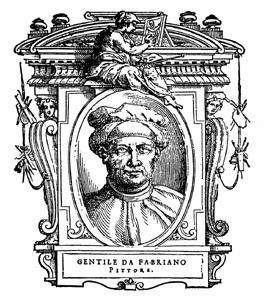
Gentile da Fabriano was an Italian painter known for his participation in the International Gothic painter style. He worked in various places in central Italy, mostly in Tuscany. His best-known works are his Adoration of the Magi from the Strozzi Altarpiece (1423), and the Flight into Egypt.

Pisanello, known professionally as Antonio di Puccio Pisano or Antonio di Puccio da Cereto, also erroneously called Vittore Pisano by Giorgio Vasari, was one of the most distinguished painters of the early Italian Renaissance and Quattrocento. He was acclaimed by poets such as Guarino da Verona and praised by humanists of his time, who compared him to such illustrious names as Cimabue, Phidias and Praxiteles.

The Adoration of the Magi is a painting by the Italian painter Gentile da Fabriano. The work, housed in the Uffizi Gallery in Florence, Italy, is considered his finest work, and has been described as "the culminating work of International Gothic painting".
The decade of the 1420s in art involved some significant events.

The Altarpiece of Saints Ursula, Martin and Anthony is a reredo by the Spanish late Gothic painter Gonzalo Pérez, dating to 1420 and housed in the Museu de Belles Arts of Valencia, Spain.

The Madonna of Humility is a tempera-on-panel painting by the Italian late medieval artist Gentile da Fabriano, dating from around 1420-1423 and housed in the Museo nazionale di San Matteo, Pisa.

The Adoration of the Christ Child is a tempera and gold on panel painting by the Italian late medieval artist Gentile da Fabriano, dating from around 1420–1421 and housed in the Getty Center of Los Angeles, United States.
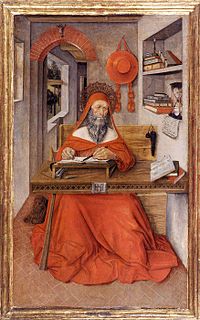
Antonio da Fabriano was an Italian painter, active in the Region of Marche.
Pietro di Domenico da Montepulciano was an Italian painter active in the Marche region.
Arcangelo di Cola was an Italian painter, active throughout central Italy in a late Gothic style.
The Master of Staffolo was an anonymous late-Gothic style painter active in the region of Marche and Umbria.
Luca di Paolo was an Italian painter mainly active in Matelica in the Marche region.

Madonna and Child is a tempera on panel painting of the enthroned Madonna and Child by Gentile da Fabriano. At its base are small angel musicians. It is now in the Galleria Nazionale dell'Umbria in Perugia.

Coronation of the Virgin is a painting by Gentile da Fabriano, executed c. 1420, now in the Getty Museum. It originated as the front of the a processional banner - the reverse showed Saint Francis Receiving the Stigmata and is now in Parma.
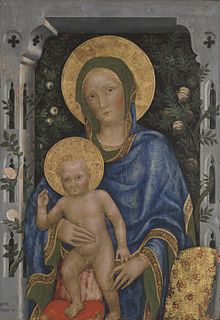
Madonna and Child is a tempera and gold on panel painting by Gentile da Fabriano, executed c. 1424, now in the Yale University Art Gallery in New Haven. It is signed on the left jamb "Gent / Fabriano". Previously traditionally dated to 1420-1423, the new accepted dating is based on similarities between the background architecture and the north door of the Florence Baptistery, completed by Lorenzo Ghiberti in 1424.
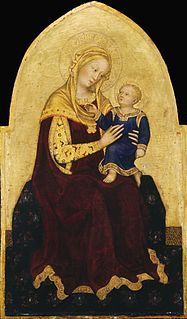
Madonna and Child is a tempera and gold on panel painting by Gentile da Fabriano, executed c. 1420-1423, now in the National Gallery of Art in Washington, D.C.. The work is generally identified as one of the first the artist produced in Florence, where he had arrived in summer 1420, at roughly the point at which he was working on the Pala Strozzi. It may have been the central panel of a polyptych, the rest of which is now lost.

Madonna and Child with Two Saints and a Donor is a c.1395-1400 tempera and gold leaf on panel painting by Gentile da Fabriano, the earliest surviving major work by the artist. Probably painted for the church of Santa Caterina in Castelvecchio in Fabriano, near to which it is now in the Gemäldegalerie in Berlin.
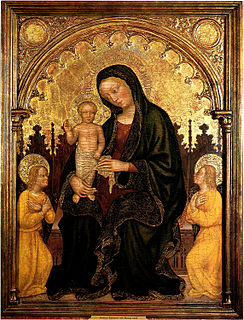
Madonna and Child Enthroned with Two Angels is a c.1410-1415 tempera and gold on panel painting by Gentile da Fabriano. Its original provenance is unknown, though its small size probably means it was made for private devotion. It is first recorded in the early 20th century, when it was in the Casa Persicini in Belluno, which suggests it links to the painter's time in Venice. It is now in the Philbrook Art Center in Tulsa, Oklahoma.















